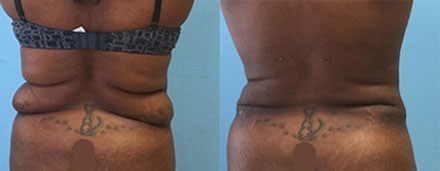A hair transplant with ARTAS or NeoGraft is a way for women to achieve thicker, fuller hair coverage on the scalp. Hair transplantation is widely considered to be a treatment sought only by men, despite the fact that many women also experience hair loss. Nowadays, increasing numbers of women are requesting information about their hair restoration options.
Hair loss in women can occur due to hormonal changes, medication usage, or underlying illness. It can even happen after pregnancy. Additionally, a condition with strong hereditary markers known as Female Pattern Hair Loss (FPHL) is estimated to affect around 30 million women in the United States alone. (1)(2) Regardless of the cause, ARTAS robotic hair transplantation and NeoGraft technology are two advanced hair restoration techniques that can provide real, impactful results for women with thinning hair.
Carolina Plastic Surgery offers individually-tailored hair transplant procedures for female patients. Board-certified plastic surgeon Dr. Saira H. Saini has dedicated her career to providing the best treatments for men and women in the Fayetteville, NC area. Call us at (910) 323-1234 or fill out an online form to book a personal consultation to discuss your treatment, and rediscover the confidence of a fuller, thicker head of hair.
Contents
Before & After Photos
[pg-promo slug=”laser-cap-hair-restoration”]
About Female Hair Loss
As the most common form of alopecia in women, female pattern hair loss can cause psychological distress and problems with social functioning. (3) It can also negatively affect self esteem. Sufferers may feel self-conscious and make an effort to disguise the condition with headwear, certain hairstyles, and accessories. But, the problem remains. FPHL
is characterized by progressive hair thinning in the frontal, central, and parietal scalp (above the ears). It is thought that genetics, hormone changes, inflammation, and environmental factors contribute to the development of the condition. (4)
What is Terminal Hair?
Terminal hair is the thick, dark hair found in various places on the body, including the scalp. It grows in a cycle that normally maintains roughly the same rate of growth, shedding and renewal. There are four stages in the hair growth cycle:
- Anagen: The growing phase. Hair growth is aided by blood supply at the root.
- Catagen: The transition phase. The hair detaches from its blood supply.
- Telogen: The shedding phase. The hair is no longer receiving nutrients, and dies.
- Exogen: The final part of the telogen phase. The hair falls out.
When a woman experiences hair loss due to FPHL, the terminal hair on her scalp thins. Disruptions to the hair cycle, particularly the shortening of the growth phase, can lead to areas of thinner hair density. The hair follicle can also shrink in a process known as miniaturization. Unlike in male pattern hair loss, this rarely happens uniformly.
Types of Hair Loss in Women
As well as FPHL, there are other conditions that cause hair loss in women.
Telogen Effluvium – Abrupt, temporary hair loss as a result of stress, trauma, or shock. In some cases, the hair loss may be a result of certain medications. The condition can occur in either sex, although women have a greater tendency to develop it. (5)
Postpartum Hair Loss – Another form of temporary hair loss can occur in the immediate period after having a baby. This usually resolves after around three months.
Cicatricial Alopecia – This is a condition that damages hair follicles. Cicatricial alopecia is inflammatory, and may lead to permanent hair loss and scarring.
Alopecia Areata – This type of alopecia is caused by the immune system attacking hair follicles. It is an autoimmune condition that may cause hair to come out in clumps.
Although some women may opt for medications such as Minoxidil, others will choose a minimally-invasive hair transplantation procedure to treat thinning hair effectively.
ARTAS Hair Restoration
ARTAS hair restoration is a physician-assisted robotic hair transplantation system. Using follicular unit extraction (FUE), ARTAS restores a thicker head of hair to men and women alike. Rather than harvesting donor hair follicles individually or in large groupings as with “hair plugs,” FUE does so in small groups. Each harvested “unit” is between 2-4 follicles. The state-of-the-art software uses artificial intelligence to accurately pinpoint and extract donor grafts. It determines which hairs are the best for harvesting in a minimally-invasive in-office procedure.
An ARTAS FUE hair transplant is a more comfortable way to regain confidence in your hair. It also causes minimal scarring compared to traditional hair transplantation techniques. Patients can look forward to:
- Intelligently selected donor hair
- Uniform pinpoint graft selection
- Unit harvesting without incisions or sutures
- A fast, straightforward recovery
- No linear scarring after treatment
- Natural-looking, fuller hair volume
Intelligent hair transplantation is the next step in cosmetic hair restoration. Experience the latest hair restoration techniques with ARTAS. Speak to Dr. Saini and discover the benefits of advanced FUE at your personal consultation!
NeoGraft Hair Restoration
NeoGraft is a manual FUE technique that harvests follicular units using a specially designed handpiece. Dr. Saini manually selects donor grafts and uses a dermal punch system attached to a vacuum, to suction away and store the harvested units. Benefits of the NeoGraft system:
- Manually operated by expert surgeon
- Minimally-invasive procedure
- Strategically relocates follicular units
- Natural-looking results
- Less downtime than conventional methods
- Comfortable, speedy recovery
Where Does the Donor Hair Come From?
A common question in the early stages of arranging a hair transplantation procedure is where the donor hair comes from. Although individual treatment plans may differ, the most common place surgeons choose to harvest from is the back of the head, also known as the mid-occipital region. On average, there are 65 to 85 follicular units per square centimeter in this area. (6)
Find out if NeoGraft or ARTAS hair restoration is a good fit for you by checking the candidate criteria below.
Candidates
If you are experiencing female hair loss, and you have good quality donor hair, you may be a good candidate for a follicular unit extraction procedure using ARTAS or Neograft. Ideal patients are healthy individuals with no serious underlying medical conditions. FUE may not be a good fit for women who:
- Suffer from heart disease or liver failure
- Have temporary hair loss
- Have severe scarring of the scalp
- Have other dermatological conditions
- Have experienced hair loss from chemotherapy
- Do not have realistic expectations
Follow Carolina Plastic Surgery on our social media for more information about our services. You can also read our informative blog detailing our surgical and non-surgical procedures.
Hair and Scalp Analysis
Women experience hair loss for a wide variety of reasons. That’s why every patient consultation for hair transplant treatment receives a hair and scalp analysis by Board Certified Plastic Surgeon Dr. Saini. During your visit, we will ask you to complete some forms that outline your medical history. We will work with you to choose the best hair restoration option for you. Dr. Saini can advise you regarding the treatment choice she determines will be best for your circumstances.
What to Expect
Once your individual treatment protocol has been determined, Dr. Saini will give you more information about how to prepare for your procedure, what to expect on the day, and how to optimize your recovery. Your treatment plan is unique to you, so should you have any questions or concerns, please do not hesitate to ask. Whether through ARTAS or NeoGraft, FUE treatment results occur in the months that follow treatment. Implantation of the donor follicular units causes each targeted hair follicle to “reawaken. After the donor hair sheds naturally, the follicle begins the anagen, or growing phase with new hair.
Cost of Hair Restoration for Women in Fayetteville, NC
The cost of ARTAS and NeoGraft hair restoration depends very much on the number of follicular units harvested. Qualified candidates may consider financing their treatment. For a clearer picture of what to expect from your treatment, please get in touch with the team at Carolina Plastic Surgery. Book a personal hair and scalp analysis with Dr. Saini at our Fayetteville office to find out more. Start your journey back to thicker hair and restore your confidence! Call (910) 323-1234 or fill out a contact form to connect with us.
FAQ
Yes! Despite a generally held assumption that hair transplants are only for men, women are increasingly discovering that they can benefit from treatment. Manual or robotic follicular unit extraction harvests donor hair from another area of the scalp and reimplants them to promote new growth.
Although it looks a little different to male pattern hair loss, female hair loss is more common than many realize. Data suggests that between 6% and 38% of women experience some degree of frontal and/or frontal-parietal hair loss (above the forehead and ears). (3)
The length of a hair transplantation procedure depends on the method of hair restoration and the number of follicular units extracted. Some procedures can exceed four hours, although patient comfort is well-regulated. For more information about the length of a hair transplant procedure, speak to your provider for an accurate estimate.
References
- Piérard-Franchimont, C., & Piérard, G. E. (2013). Alterations in Hair Follicle Dynamics in Women. BioMed Research International, 2013, 957432. https://doi.org/10.1155/2013/957432
- Peyravian, N., Deo, S., Daunert, S., & Jimenez, J. J. (2020). The Inflammatory Aspect of Male and Female Pattern Hair Loss. Journal of Inflammation Research, Volume 13, 879–881. https://doi.org/10.2147/jir.s275785
- Fabbrocini, G., Cantelli, M., Masarà, A., Annunziata, M. C., Marasca, C., & Cacciapuoti, S. (2018). Female pattern hair loss: A clinical, pathophysiologic, and therapeutic review. International Journal of Women’s Dermatology, 4(4), 203–211. https://doi.org/10.1016/j.ijwd.2018.05.001
- Bhat, Y. J., Saqib, N.-U. -, Latif, I., & Hassan, I. (2020). Female Pattern Hair Loss—An Update. Indian Dermatology Online Journal, 11(4), 493–501. https://doi.org/10.4103/idoj.IDOJ_334_19
- Hughes, E. C., & Saleh, D. (2019, July 3). Telogen Effluvium. Nih.gov; StatPearls Publishing. https://www.ncbi.nlm.nih.gov/books/NBK430848/
- Zito, P. M., & Raggio, B. S. (2021). Hair Transplantation. PubMed; StatPearls Publishing. https://www.ncbi.nlm.nih.gov/books/NBK547740/




